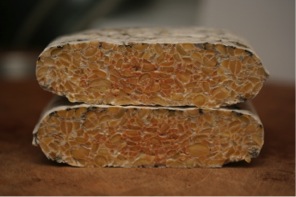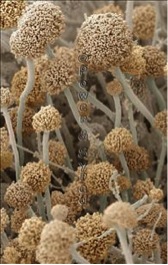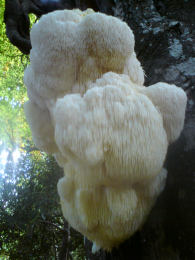By: Elizabeth Gulick
Two handfuls of chanterelle mushrooms in a stir-fry; a delicious pizza topped with portabella fungi, and deep fried tempeh?! Edible fungus is vast, intriguing, and a nice source of nutrition for many animals, including us humans. Perhaps you have tried fried Tempeh strips or a tempeh-‘reuben’ sandwich from LeVoyeur in Olympia, WA? (yum!)
Tempeh is made from growing the fungus (aka mold/mould) Rhizopus oligosporus on soybeans or on other plant substrates like wheat, other grains, and beans. It is enjoyed worldwide for its edibility, unique flavor, and nutritional and medicinal qualities.
Tempeh’s appearance is peculiar; white fluffy mushroom mycelium enwraps the yellow soybeans (or whatever plant-food used) and holds it firmly together thus creating a flexible, bendable, and nicely chewy texture. It is most commonly sold in rectangular chunks about an inch thick. As it grows, the exposed surface develops some black and grey coloration, which is evidence of the fungus’ spores.

This blog has beautiful pictures of preparing tempeh:
Tempeh originated in today’s Indonesia, where it is a staple source of protein. “Traditional tempeh is often produced in Indonesia using Hibiscus tiliaceus leaves. The undersides of the leaves are covered in downy hairs known technically as trichome
s to which the mold Rhizopus oligosporus can be found adhering to in the wild. Soybeans are pressed into the leaf, and stored. The earliest known reference to it appeared in 1815 in the Serat Centhini (Wikipedia).” Since then it has spread throughout the world picking up popularity among the poor and vegetarians because of its cheapness and nutritional value.
Tempeh is delicious, and! Some say when fried it tastes like fried chicken; I say it has an earthy taste. My favorite way to prepare Tempeh is to pan-fry strips of it in coconut oil until it is well done and then sprinkle nutritional yeast and salt on the fried bean-Fungi. It is much firmer and flavorful than tofu.
Not only is Tempeh tasty, it has nutritional value as well. Tempeh made from soybeans is a fantastic source of protein. It is better than tofu because the soybeans have been pre-digested during the fermentation process. “The mycelium of R. oligosporus penetrates several layers into the soybean cotyledon. Mycelia colonize the intercellular material and solubize it by the activity of extracellular enzymes. Rhizopus spp. produce lipases, proteases, phytases and a variety of carbohydrateses (Boris Kovac & Peter Raspor, 1996).”
Tempeh is also better than tofu or cooked beans/grains because of the process of fermentation which it undergoes. “Many anti-nutritional factors can be found in unfermented legume seeds. During soaking and heating, and because of fungal enzymatic activity, almost all the anti-nutritious factors such as protease inhibitors, tannins, phytic acids, and lectins are removed” (Boris Kovac & Peter Raspor, 1996). Another scientific paper states, “The complex sugars stachyose and raffinose, which cause flatulence, are broken down into digestible sugars. During fermentation, the fungus produces the enzyme phytase that mobilizes the phytic acid improving bioavailability of minerals. Fermentation also promotes the synthesis of B group vitamins” (Ana Bavia, Carlos Silva, Maria Ferreira, Rodrigo Leite, Jose Mandarino, 2012).
Fermentation promotes B Vitamins? There is a special reason for this and it involves another microscopic friend: bacteria. “During soaking (of the beans to be used), spontaneous fermentation by bacteria occurs. Bacterial microflora , in which lactobacillus species are dominant, cause acidification of the beans and inhibition of some pathogenic bacteria. Although the mould increases the amount of physiologically active vitamins, the only source of vitamin B12 in tempeh products fermented by R. oligosporus are spoilage bacteria which appear during the soaking or fermentation of beans” (Boris Kovac & Peter Raspor, 1996). Bacteria and fungus, in the case of Tempeh, is a very nice pair!
 Tempeh incubating in plastic bags inside an oven.
Tempeh incubating in plastic bags inside an oven.
Tempeh has medicinal qualities as well. “Some desirable effects on human health are obtained in Rhizopus oligosporus products. Reduction of the serum cholesterol level is obtained by a tempeh diet in rats. The effect of decreasing cholesterol is presumably attributable to the lecithin, niacin, sitosterol and unsaturated fatty acids in tempeh. Rhizopus oligosporus produces components with high antioxidative activity. Nutritional rehabilitation of chronic diarhetic children with tempeh-milk based formula was evaluated. Recovery from diarrheal disease was reported to be faster with the tempeh based formula and resulted also in better weight gain, immunological values, and increase of hemoglobin (Boris Kovac & Peter Raspor, 1996).”

Rhizopus micrograph
Tempeh is inexpensive and easy to culture at home. It takes about 24 hours to grow Rhizopus onto soybeans or other substrate. Traditionally it is grown wrapped up in banana leaves; in developed countries it is often grown in plastic bags with tiny pin holes punched in them to allow air flow (not too much air or the mould will produce spores too quickly). You can purchase spores and inoculate your substrate with them, or you can mix in remnants of previous batches of tempeh to inoculate the new substrate. The hardest obstacle is keeping the temperature during the time of incubation at a steady 85 to 90 degrees F. Another common mistake is having too much moisture in the beans; too much moisture during incubation can breed the wrong kinds of bacteria.
Image from here.
Fermentation is a historic and a delicious act that has fed humanity for longer than we have had grocery stores. Whether you are a vegetarian, carnivore, or simply fungus friendly you can appreciate Tempeh for it’s inexpensive, quick, tasty, and nutritious qualities. Much like ruminants make vegetative proteins available to humans, the tempeh fungus transforms some grains economically and sustainably. Tempeh could become more and more popular as the world population continues to grow. More at-home tempeh production could ensure cheap localized protein sources worldwide.
References:
Alan Jurus. , & Walter Sundberg, (1976). Penetration of rhizopus oligosporus into soybeans in tempeh. Applied and Environmental Microbiology, 32(2), 284-287.
Ana Carla Furlan Bavia. , Carlos Eduardo da Silva, , Maria Pires Ferreira, , Rodrigo Santos Leite, , & Jose Marcos Gontijo Mandarino, (2012). Chemical composition of tempeh from soybean cultivars specially developed for human consumption. Science and Technology de Alimentos, 32(3), 613-620.
Boris Kovac. , & Peter Raspor, (1996). The use of the mould rhizopus oligosporus in food production. Food Technology, 35(1), 69-73.
Vikas Kumar. , Amit Sinha, , Harinder Makkar, , & Klaus Becker, (2010). Comparative effect of boiling and solid substrate fermentation using the tempeh fungus (rhizopus oligosporus) on the flatulence potential of african yambean (sphenostylis stenocarpa l.) seeds. Food Chemistry, 103(4), 945-959.
Wikipedia. “Rhizopus oligosporus” (http://en.wikipedia.org/wiki/Rhizopus_oligosporus)
Wikipedia. “Tempeh” (http://en.wikipedia.org/wiki/Tempeh)
William Scurtleff. , & Akiko Aoyagi, (1985). The history of tempeh: A fermented soyfood from indonesia by william schurtleff. Agricultural History, 59(4), 598-600.




